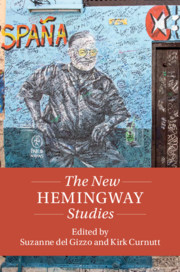Book contents
- The New Hemingway Studies
- Twenty-First-Century Critical Revisions
- The New Hemingway Studies
- Copyright page
- Contents
- Contributors
- Introduction Hemingway in the New Millennium
- Part I The Textual Hemingway
- Part II Identities
- Chapter 6 Family Dynamics and Redefinitions of “Papa”-hood
- Chapter 7 Hemingway and Pleasure
- Chapter 8 Trauma Studies
- Chapter 9 Hemingway and Queer Studies
- Chapter 10 Hemingway, Race(ism), and Criticism
- Chapter 11 Still Famous after All These Years
- Part III Global Engagements
- Works Cited
- Index
Chapter 10 - Hemingway, Race(ism), and Criticism
from Part II - Identities
Published online by Cambridge University Press: 30 August 2020
- The New Hemingway Studies
- Twenty-First-Century Critical Revisions
- The New Hemingway Studies
- Copyright page
- Contents
- Contributors
- Introduction Hemingway in the New Millennium
- Part I The Textual Hemingway
- Part II Identities
- Chapter 6 Family Dynamics and Redefinitions of “Papa”-hood
- Chapter 7 Hemingway and Pleasure
- Chapter 8 Trauma Studies
- Chapter 9 Hemingway and Queer Studies
- Chapter 10 Hemingway, Race(ism), and Criticism
- Chapter 11 Still Famous after All These Years
- Part III Global Engagements
- Works Cited
- Index
Summary
In “Hemingway, Race(ism), and Criticism,” Ian Marshall surveys the recent surge of criticism on Hemingway and race exemplified by the work of Marc K. Dudley, Amy L. Strong, Gary Edward Holcomb, and Charles Scruggs, among many others. In a provocative argument, he insists that examinations of this topic do not sufficiently decenter the author and thus end up as character testimonials, attempting to gauge the degree to which Hemingway was/was not racist. Marshall instead argues that Hemingway’s leftist politics should be recognized (at least before his 1950s shift to the moderate right) to appreciate the influence of his stance on class divisions on Ralph Ellison. Insisting that critics have misunderstood Ellison’s supposed abandonment of radicalism after the 1940s, he argues that black writers have been far more wary and suspicious of Hemingway than Hemingway scholarship has admitted. He then concludes by noting the particularly inspiring use of comparative pedagogies to open the canon and introduce readers to the Harlem Renaissance as a counterpoint to Hemingway.
- Type
- Chapter
- Information
- The New Hemingway Studies , pp. 161 - 175Publisher: Cambridge University PressPrint publication year: 2020

